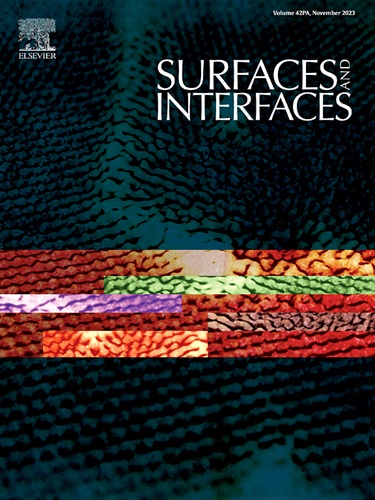Synthesis and characterization of a high-performance magnetic nanocomposite adsorbent from pomegranate pomace waste for tannery wastewater treatment
IF 5.7
2区 材料科学
Q2 CHEMISTRY, PHYSICAL
引用次数: 0
Abstract
Effective management of organic and chemical pollutants is crucial for the leather industry. In this study, a novel magnetic nanocomposite (AC/Fe₃O₄)PP) was synthesized from pomegranate juice processing waste, an agro-industrial byproduct, and used for treating real tannery wastewater from MEGA/EPE-Spa, a local leather industry in Batna, East Algeria (35°33′52.8"N 6°10′22.5"E), at three different stages. The pomace waste served as a precursor for activated carbon (AC-PP) production, while its extract functioned as a coating agent for synthesizing magnetic iron oxide nanoparticles (Fe₃O₄@PP-NPs). Combining these two adsorbents yielded the (AC/Fe₃O₄)PP nanocomposite, which demonstrated outstanding adsorption performance. The high surface area of AC (>1400 m²/g) enabled efficient pollutant removal, and the magnetic properties of the Fe₃O₄ component facilitated easy separation and recovery. Detailed characterization of the Fe₃O₄@PP-NPs, AC-PP, and (AC/Fe₃O₄)PP adsorbents was conducted. The optimal doses and contact times were 0.3 g/L for (AC/Fe₃O₄)PP with 30 minutes, 0.5 g/L for AC-PP with 40 minutes, and 0.8 g/L for Fe₃O₄@PP-NPs with 60 minutes, all at an initial concentration of 100 mg/L. The Langmuir isotherm showed high adsorption capacities, with values of 372.37 mg/g for AC, 827.6 mg/g for NPs, and 962.31 mg/g for the (AC/Fe₃O₄)PP nanocomposite. Adsorption mechanism studies revealed a mixed control process involving both external and intraparticle diffusion. The (AC/Fe₃O₄)PP nanocomposite effectively treated tannery wastewater, achieving high removal rates of COD, BOD₅, turbidity, and TDS across all treatment stages. These results position (AC/Fe₃O₄)PP as a promising, cost-effective solution for tannery wastewater treatment, addressing existing gaps in the current literature by offering a sustainable and efficient method for pollutant removal.

制革废水处理用石榴渣高效磁性纳米复合吸附剂的合成与表征
有效管理有机和化学污染物对皮革工业至关重要。在这项研究中,以一种新型的磁性纳米复合材料(AC/Fe₃O₄)PP为原料,合成了一种新型的磁性纳米复合材料(AC/Fe₃O₄)PP),并将其用于处理阿尔及利亚东部Batna(35°33′52.8”N 6°10′22.5”E)当地皮革工业MEGA/EPE-Spa的实际制革厂废水。废渣作为生产活性炭(AC-PP)的前驱体,而其提取物作为合成磁性氧化铁纳米颗粒(Fe₃O₄@PP-NPs)的包衣剂。将这两种吸附剂结合制备了(AC/Fe₃O₄)PP纳米复合材料,该材料具有优异的吸附性能。AC的高表面积(>1400 m²/g)使污染物能够有效去除,Fe₃O₄组分的磁性使其易于分离和回收。对Fe₃O₄@PP-NPs、AC-PP和(AC/Fe₃O₄)PP吸附剂进行了详细的表征。在初始浓度为100 mg/L的条件下,(AC/Fe₃O₄)PP的最佳剂量为0.3 g/L,接触时间为30 min, AC-PP的最佳剂量为0.5 g/L, Fe₃O₄@PP-NPs的最佳剂量为0.8 g/L,接触时间为60 min。Langmuir等温线吸附AC的吸附量为372.37 mg/g, NPs的吸附量为827.6 mg/g, (AC/Fe₃O₄)PP纳米复合材料的吸附量为962.31 mg/g。吸附机理研究揭示了一个混合控制过程,包括颗粒内扩散和外部扩散。(AC/Fe₃O₄)PP纳米复合材料有效地处理了制革厂废水,在所有处理阶段实现了COD, BOD₅,浊度和TDS的高去除率。这些结果表明(AC/Fe₃O₄)PP是一种有前途的、具有成本效益的制革废水处理解决方案,通过提供一种可持续的、有效的污染物去除方法,解决了目前文献中存在的空白。
本文章由计算机程序翻译,如有差异,请以英文原文为准。
求助全文
约1分钟内获得全文
求助全文
来源期刊

Surfaces and Interfaces
Chemistry-General Chemistry
CiteScore
8.50
自引率
6.50%
发文量
753
审稿时长
35 days
期刊介绍:
The aim of the journal is to provide a respectful outlet for ''sound science'' papers in all research areas on surfaces and interfaces. We define sound science papers as papers that describe new and well-executed research, but that do not necessarily provide brand new insights or are merely a description of research results.
Surfaces and Interfaces publishes research papers in all fields of surface science which may not always find the right home on first submission to our Elsevier sister journals (Applied Surface, Surface and Coatings Technology, Thin Solid Films)
 求助内容:
求助内容: 应助结果提醒方式:
应助结果提醒方式:


